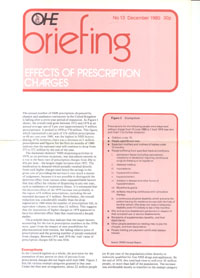Sign up to our newsletter Subscribe
Analysing Global Immunisation Expenditure

The annual number of NHS prescriptions dispensed by chemist and appliance contractors in the United Kingdom is falling after a seven year period of expansion. As Figure 1 shows, the overall total grew between 1972 and 1978 at an annual average rate of…
The annual number of NHS prescriptions dispensed by chemist and appliance contractors in the United Kingdom is falling after a seven year period of expansion. As Figure 1 shows, the overall total grew between 1972 and 1978 at an annual average rate of 3 per cent (approximately 9 million prescriptions). It peaked in 1978 at 378 million. This figure, which represented a net gain of 154 million prescriptions or 69 per cent over 1949, was the highest in NHS history. During 1979, however, there was a decrease of 3 million prescriptions and figures for the first six months of 1980 indicate that the national total will continue to drop from 375 to 372 million by the end of the year.
The slackened chemists’ NHS dispensing activities in 1979, as on previous occasions, was due almost entirely to a rise in the basic rate of prescription charges from 20p to 45p per item – the largest single increase since 1952. The moderation in demand which actually resulted directly from such higher charges (and hence the savings in the gross cost of providing the service) is very much a matter of judgement, because it is not possible to distinguish the deterrent effect f r om various other unquantifiable factors that may affect the volume of dispensing in any one year, such as epidemics of respiratory illness. It is estimated that the deterrent effect of the 1979 increase was probably in the region of 9 million prescriptions, including the net recorded decrease of 3 million. Nevertheless, the overall reduction was considerably smaller than the drop registered in 1968 when the number of prescriptions fell, in equivalent volume, by more than 12 million. This suggests that the imposition of higher charges in 1979 appeared to have less deterrent effect than that experienced a decade earlier.
The available data thus indicate that the major factors accounting for the rise in prescription numbers in the 1970s were, apart from the impact of new possibilities for pharmaceutical intervention, the falling relative price of prescriptions and the growing number of people exempted from charges. Between 1971 and 1979 the ‘real’ value of prescription charges fell by one-fifth.
Effects of Prescription Charges
